American football, a sport renowned for its strategic depth, intense physicality, and captivating gameplay, has captured the hearts of millions worldwide. For beginners looking to delve into this exhilarating sport, understanding its nuances is essential for both enjoyment and skill development.
In this comprehensive guide, “Mastering American Football: Pro Tips for Beginners,” we will explore fundamental techniques, strategies, and fitness tips to help novices navigate the complexities of the game. In addition we will explore the positions and roles of players in american football and the size and dimensions of a football field.
Whether you aspire to play competitively or simply wish to enhance your understanding and appreciation of the sport, this article serves as your gateway to mastering the basics of American football, setting the foundation for a journey filled with excitement, learning, and personal growth.
History
American football’s roots trace back to the late 19th century, evolving from games like rugby and soccer. It was in 1869 that Rutgers and Princeton played what is often considered the first college football game. However, the sport truly began to take shape with the pivotal contributions of Walter Camp, known as the “Father of American Football.” Camp’s significant changes, including the introduction of the line of scrimmage and the concept of downs, transformed the game from its rugby origins into a unique American sport.
Throughout the 20th century, American football surged in popularity, bolstered by the establishment of major leagues like the National Football League (NFL) in 1920. As it grew, the sport not only became a staple of American culture but also a reflection of the country’s evolving social and cultural landscape, fostering a rich history that continues to captivate audiences globally.
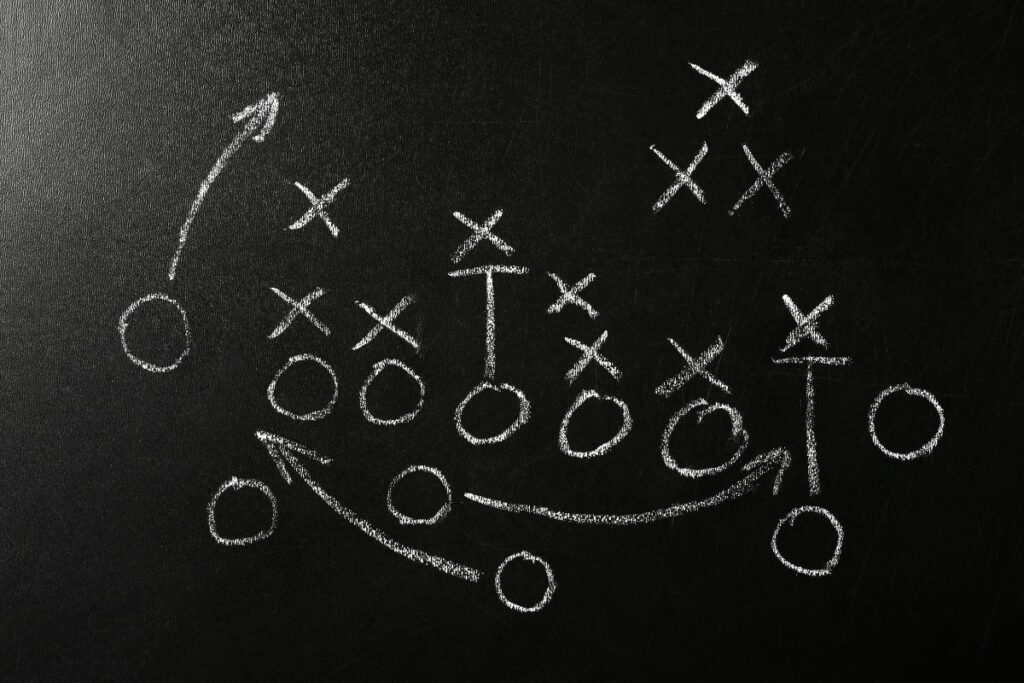
Creation
The creation of American football cannot be attributed to a single individual, but Walter Camp, a coach and sports writer, played a crucial role in shaping its modern form. Camp’s adaptations to the rules of rugby in the late 19th century laid the groundwork for what would become American football. These changes included establishing the line of scrimmage, the system of downs, and the forward pass.
The evolution of the National Football League (NFL), from its humble beginnings as the American Professional Football Association in 1920 to its current status as a global sports juggernaut, reflects the growing popularity and commercialization of the sport. The NFL’s expansion, television deals, and the Super Bowl’s emergence as a cultural phenomenon exemplify how American football has evolved into more than just a sport, becoming an integral part of American cultural identity and entertainment.
Superbowl
The iconic 1969 Super Bowl III, featuring the NFL’s Baltimore Colts and the AFL’s New York Jets, holds a special place in football history as a pivotal moment leading to the NFL-AFL merger. Prior to this game, the NFL was widely considered superior to the younger AFL. The Jets, led by quarterback Joe Namath, who famously guaranteed a victory, were heavy underdogs against the Colts. However, in a stunning upset, the Jets won 16-7, proving the competitiveness of the AFL and altering the perception of the league.
This game not only bolstered the legitimacy of the AFL but also set the stage for the merger of the two leagues in 1970. The merger created a unified NFL and established the Super Bowl as the championship game, symbolizing a new era in professional American football and laying the groundwork for the modern landscape of the sport.

People Who Shaped the Game
The NFL has been profoundly influenced by numerous players, coaches, and owners, each leaving an indelible mark on the sport.
Players:
- Jerry Rice: Widely regarded as the greatest wide receiver in NFL history, Rice holds numerous records, including most career receptions, receiving yards, and receiving touchdowns. His work ethic and route-running precision set new standards for his position.
- Tom Brady: Known for his remarkable longevity and success, Brady has won multiple Super Bowl titles and MVP awards. His leadership and ability to perform under pressure have made him one of the most respected quarterbacks in NFL history.
- Lawrence Taylor: Taylor revolutionized the linebacker position with his speed and power, redefining how defense was played in the NFL. He was a dominant force, winning several Defensive Player of the Year awards and an MVP.
Coaches:
- Vince Lombardi: A symbol of excellence, Lombardi’s name adorns the Super Bowl trophy. He led the Green Bay Packers to five NFL championships in seven years, including the first two Super Bowls, and is celebrated for his leadership and motivational skills.
- Bill Belichick: Known for his strategic brilliance, Belichick has led the New England Patriots to numerous Super Bowl victories. His ability to adapt and outsmart opponents has made him one of the most successful coaches in NFL history.
- Don Shula: Holding the record for the most wins by an NFL head coach, Shula’s Miami Dolphins achieved the only perfect season in NFL history. His consistent success over decades set a high bar for coaching excellence.
Owners:
- Al Davis: As the owner of the Oakland Raiders, Davis was known for his motto, “Just win, baby.” He was influential in league decisions and was a pioneer in the hiring of minority coaches and executives.
- Jerry Jones: The owner of the Dallas Cowboys, Jones transformed the team into one of the most valuable sports franchises globally. He was instrumental in shaping the NFL’s marketing and broadcast deals.
- Robert Kraft: Owner of the New England Patriots, Kraft has overseen a period of unprecedented success for the team. He’s been influential in labor negotiations and league broadcasting rights, significantly impacting the NFL’s growth and profitability.
Each of these individuals has not only contributed to their teams’ successes but also shaped the NFL’s evolution, impacting the game on and off the field. Their legacies are not just in their achievements and awards but in the lasting influence they have had on the sport of American football.
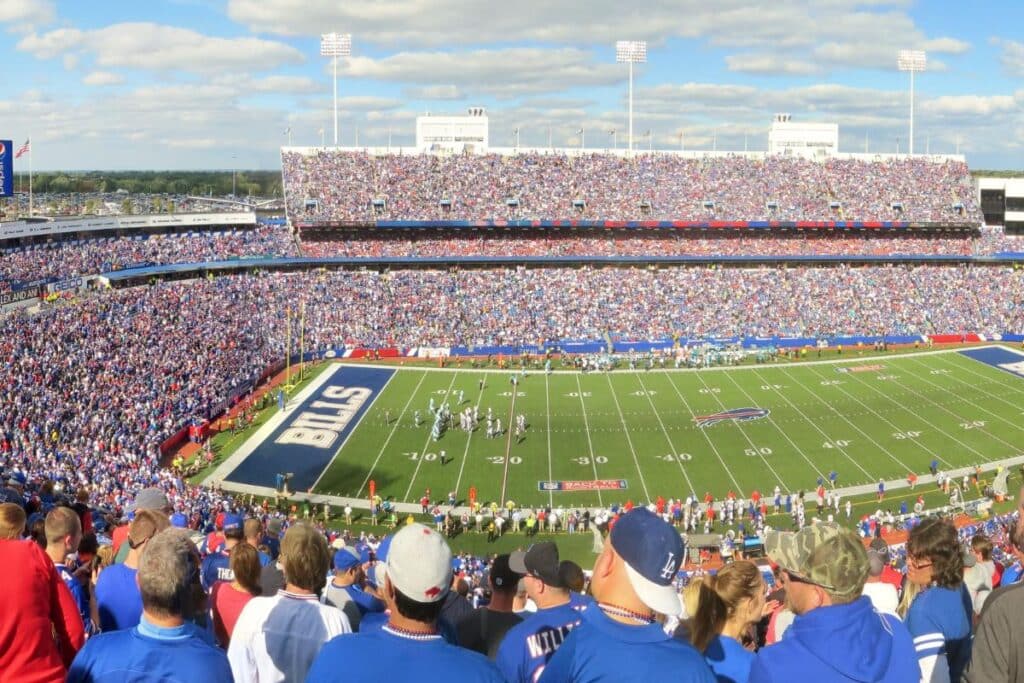
Understanding the Game of Professional American Football:
American football is played between two teams, each with 11 players. The objective is simple: score more points than the opponent within the game’s duration, typically four 15-minute quarters. In addition after the second quarter, there is a half time where both teams leave the field and go into the locker room to make adjustment and discuss strategy. Finally if no one is winning after the game ends there is fifth quarter called overtime.
Time Management
Time management is crucial. Teams get three timeouts per half, and strategic use can influence the game’s outcome. The clock stops for various reasons, like incomplete passes or players going out of bounds, adding a layer of strategy.
Regular Time
Points are scored mainly through touchdowns (6 points), followed by extra point attempts (1 or 2 points), field goals (3 points), and safeties (2 points). In American football, points can be scored by players on offense, defense, and special teams, each contributing in unique ways.
overtime
In American football, the overtime rules are designed to determine a winner in the event of a tie at the end of regulation time. The format for overtime varies between the regular season and playoffs.
In the regular season, the NFL employs a sudden death format: the first team to score any points wins the game. The overtime period is 10 minutes, and if neither team scores, the game ends in a tie.
In the playoffs, the rules ensure each team has the opportunity to possess the ball at least once, unless the team that receives the overtime kickoff scores a touchdown on its first possession. If the team that possesses the ball first only scores a field goal, the other team gets a chance to score; if they score a touchdown, they win; if they score a field goal, the game continues. If the score remains tied after each team has had a possession, then the next score, by any means, wins the game. This overtime format adds a strategic layer to the game, as teams must balance aggressive play with tactical decisions to secure a victory.
Offense Scoring
On offense, any player is eligible to score a touchdown, worth six points, by carrying the ball into the end zone. However only eligible player – running backs, receivers, tight ends and offense lineman who report to the referee as eligible receivers can receive a pass while in the end zone.
Following a touchdown, the team has the option to attempt an extra point (worth one point) by kicking the ball through the goalposts from the 15-yard line, or a two-point conversion from the two-yard line by either running or passing the ball into the end zone again.
Special Teams Scoring
Special teams come into play mainly through field goals, which are worth three points and can be scored by kicking the ball through the uprights from anywhere on the field during a play.
In addition on special teams, a punt returner or kickoff returner has the opportunity to score touchdowns during special teams plays, adding a dynamic layer to the game. When the opposing team kicks the ball (kickoff or punt) after failing to advance it, scoring, or a safety, then the returner catches it and attempts to advance it back towards the opponent’s end zone.
defense Scoring
Defensively, players can score by tackling an offensive player with the ball in the offense’s end zone, resulting in a safety, which awards the defense two points. Additionally, defensive players can score touchdowns by intercepting a pass or recovering a fumble and returning it to the offense’s end zone. This versatility in scoring makes every unit on the field a potential contributor to the team’s point total.

Field Dimensions and Gameplay:
The game unfolds on a 100-yard-long field, marked by 10-yard divisions, with end zones at each end. Each team has four downs or plays to advance the ball 10 yards. Failure to do so results in a turnover. Teams can move the ball by running or passing it, while the opposing team aims to stop this progress and take control of the ball.
Kicking
In American football, kicking or punting the ball occurs in specific situations governed by the game’s rules. A kickoff is performed at the start of each half and after every touchdown and field goal. During a kickoff, the ball is kicked from the kicking team’s 35-yard line to the receiving team, which tries to advance the ball as far as possible.
A field goal attempt, where the ball is kicked through the uprights of the goalpost, typically happens on fourth down when the team believes they are close enough to score but not confident in securing a first down or touchdown. Each of these kicking situations plays a crucial role in the strategy and flow of an American football game, often significantly impacting field position and the game’s outcome.
Punting
Punting, on the other hand, is a strategic choice typically used on the fourth down when the team with the ball (the offense) is too far from the first down marker and decides it’s not feasible to try to continue their drive. By punting, the offense kicks the ball downfield to the opposing team, aiming to push them back and make their drive to score more challenging.
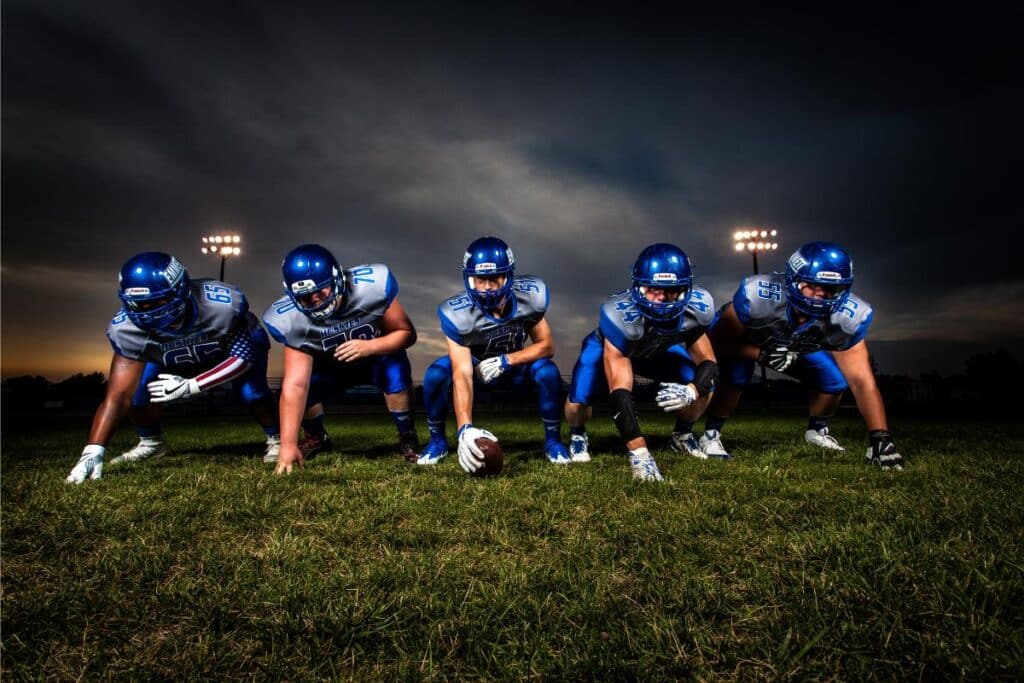
Player Positions and Roles:
American football is a game of specialized roles, with each position having distinct responsibilities that contribute to the team’s overall strategy.
Offense
On offense, the quarterback is the leader, responsible for passing or handing off the ball. Running backs carry the ball on run plays, while wide receivers and tight ends are primary targets for passes. The offensive line, consisting of guards, tackles, and the center, protects the quarterback and opens up lanes for running plays by blocking. The offense has the ball and aims to score touchdowns and two point conversions.
| WR1 | TE | Tackle | Guard | Center | Guard | Tackle | WR2 |
| Quarterback | |||||||
| RB1 | RB2 |
Formations
In American professional football, teams employ a variety of offensive formations, each designed to maximize the strengths of their players and exploit the weaknesses of the defense. The Pro Set, also known as the split-back formation, features two running backs lined up behind the quarterback, offering a balanced attack between running and passing plays.
The Shotgun formation positions the quarterback several yards behind the center, providing more time to see the defense and execute passes. A variation of this is the Pistol, where the quarterback stands closer to the line of scrimmage, allowing for effective running and passing plays.
The Single-Back formation includes one running back, with the focus on spreading out the defense for passing attacks. The I-Formation is a traditional set-up that lines up two running backs directly behind the quarterback, ideal for power running plays. The Spread Offense utilizes multiple wide receivers to stretch the defense horizontally, creating space for short, quick passes or quarterback runs.
Additionally, the Wildcat formation directly snaps the ball to a running back or wide receiver instead of the quarterback, adding an element of surprise. Each of these formations has its strategic uses, and teams often switch between them based on their game plan and the in-game situation.
Defense
On defense, defensive linemen aim to break through the offensive line to tackle the quarterback or stop running plays. Linebackers, positioned behind the linemen, play a versatile role, tackling runners, covering receivers, or rushing the quarterback. Defensive backs, including cornerbacks and safeties, primarily defend against pass plays by covering receivers or intercepting the ball.
The defenses’ goal is to stop the offense. Positions include Linemen (tackle the quarterback), Linebackers (defend against the run and pass), and Defensive Backs (guard against receivers).
| Defensive End | Defensive Tackle | Defensive Tackle | Defensive End | |||
| Outside Linebacker | Inside Linebacker | Outside Linebacker | ||||
| Cornerback | Strong Safety | Weak Safety | Cornerback |
Formations
In American professional football, defensive formations are strategically varied to counter the offense’s play style and adapt to different game situations. The 4-3 Defense, one of the most common formations, employs four defensive linemen and three linebackers, offering a balanced approach to stopping the run and pass. Its counterpart, the 3-4 Defense, uses three linemen and four linebackers, providing greater flexibility for blitzes and pass coverage.
The Nickel Formation, crucial in pass defense, brings in an extra defensive back, the nickelback, in place of a linebacker, enhancing the defense against multiple receiver sets. The Dime Formation further escalates this approach by adding yet another defensive back, sacrificing size for speed and coverage ability against passing plays.
For an aggressive approach, the Blitz involves linebackers or defensive backs charging towards the quarterback to disrupt pass attempts, at the risk of leaving receivers less covered. The Zone Defense sees defenders covering specific areas of the field, rather than man-marking individual players, aiming to intercept passes or contain plays within their zone.
Lastly, the Goal Line Defense is employed in critical situations near the end zone, prioritizing stopping the run with more linemen and linebackers near the line of scrimmage. Each formation is a chess match against the offensive strategy, requiring players to adapt and execute their roles precisely.
special Teams
Special teams specialized for kicking plays, like kickoffs and punts. Key roles include the Kicker (field goals, extra points), Punter (kicks the ball away on fourth down), and Return Specialists (return kicks and punts).
The returners can score touchdowns if they are able to reach the other teams end zone during the return. Each player’s role is integral to the team’s success, requiring specific skills, physical attributes, and mental acuity to execute their responsibilities effectively.
The special teams kicks and receives the ball with the aim to score and prevent touchdowns, field goals and and extra point conversions.
Other Special Teams Players
In American professional football, special teams play a crucial role in the game’s outcome, with specific positions tailored for these critical moments. The long snapper is a specialized center who snaps the ball over a longer distance than usual during field goal attempts, extra points, and punts. Precision and speed are vital for a long snapper to ensure successful plays.
Gunners are key players on punt and kickoff units, known for their speed and tackling ability. Their primary role is to quickly get down the field and tackle the returner, often breaking through the opposing team’s blockers.
Lastly, the holder is an essential part of field goal and extra point attempts. Usually the team’s punter or backup quarterback, the holder catches the long snap and holds the ball in place for the kicker. The holder’s ability to securely catch and accurately place the ball, often under high-pressure situations, is critical for the success of the kick. These roles, though less highlighted, are integral to a team’s performance, often influencing field position and scoring opportunities in subtle yet impactful ways.
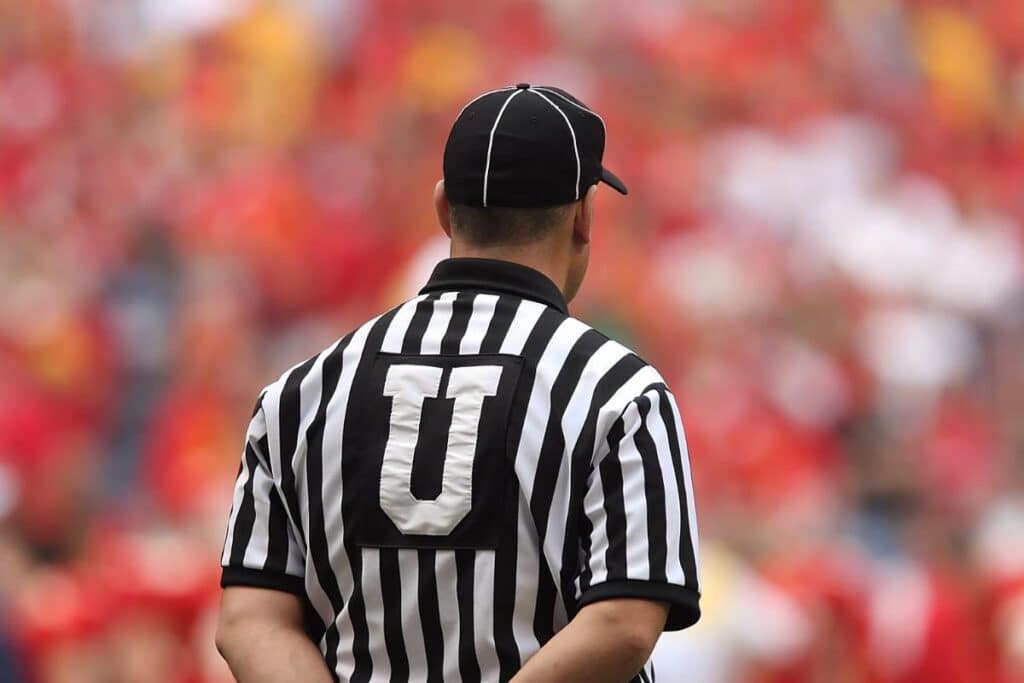
The Role of Referees:
Referees enforce rules, ensure fair play, and keep the game safe. They make crucial calls that can impact the game’s flow and outcome.
Game Officials
In a professional American football game, referees and officials play a vital role in ensuring the game’s rules are properly enforced, maintaining fair play, and keeping the game safe for the players. The crew consists of several types of officials, each with specific responsibilities.
The Referee is the crew chief, responsible for the general supervision of the game, making announcements of penalties, and deciding disputes among other officials. The Umpire positions themselves behind the defensive line, primarily overseeing the line of scrimmage, checking the legality of the offensive line’s formation, and watching for holding or illegal blocks.
The Down Judge (formerly known as the Head Linesman) ensures the correct down is displayed and oversees line-of-scrimmage issues on their side of the field. The Line Judge assists with offside and encroachment calls and monitors the receivers for illegal motion or shifts. The Field Judge, Side Judge, and Back Judge are responsible for watching the play in the secondary, focusing on pass interference, illegal hits, and ensuring receivers and defenders are playing within the rules.
Together, this team of officials maintains the structural integrity of the game, applying the rules consistently and objectively to provide a fair and orderly framework for the contest. Their roles are critical, as they directly affect the flow and outcome of the game through their calls and interpretations of the rules.
Replay Review System
In professional American football, the instant replay review system allows referees to review certain types of plays to ensure the correct call is made, enhancing the game’s fairness. Plays that can be reviewed include but are not limited to scoring plays, turnovers, the location of the ball in relation to first down markers, and whether a pass was complete, incomplete, or intercepted.
However, some plays are non-reviewable, such as penalties (except for a few like pass interference), the forward progress of a ball carrier, and judgment calls like holding or pass interference. Each team is allowed two challenges per game. To initiate a challenge, a coach must throw a red flag onto the field before the next play begins. If a challenge is successful, the team retains the right to one additional challenge, for a maximum of three.
However, if the challenge is lost, the team is charged a timeout. If a team is out of timeouts, it cannot challenge a play. Additionally, within the last two minutes of each half and during overtime, all reviews are initiated by the officials in the replay booth, not by team challenges. This system of challenges and reviews plays a crucial role in the game’s strategy, as coaches must decide when to risk a timeout to potentially overturn a critical call on the field.
Professional American Football Safety Concerns
Safety in professional American football has become a paramount concern, especially with increasing awareness of the long-term impact of concussions and other injuries. The NFL has implemented strict protocols for managing concussions, emphasizing the importance of proper diagnosis and ensuring players receive adequate medical attention and recovery time before returning to play.
Alongside this, the league continually educates players on proper tackling techniques, encouraging the use of the shoulder instead of the head and teaching methods to reduce head-first collisions. This is part of a broader effort to minimize head injuries.
Furthermore, the NFL has banned specific types of contact to enhance player safety. These include helmet-to-helmet hits, hits on a defenseless player, horse-collar tackles (grabbing the inside collar of the back of the shoulder pads or jersey), and leading with the helmet to initiate contact against an opponent. Penalties for these infractions can be severe, including fines, suspensions, and in some cases, ejection from the game.
These measures reflect the NFL’s commitment to player safety, acknowledging the physical demands of the sport while striving to reduce the risk of serious injuries.
Fitness Tips for Beginners:
- Cardiovascular Endurance: Essential for stamina, especially for positions requiring constant movement.
- Strength Training: Focus on compound movements for overall strength, crucial for tackling and blocking.
- Agility Drills: Improve your ability to change direction quickly.
- Flexibility: Reduces the risk of injuries and aids in recovery.
Conclusion:
Delving into American football as a beginner can be daunting, but understanding its rules, strategies, and fitness requirements makes it more enjoyable and accessible. Whether your goal is to play, coach, or simply enjoy the game as a spectator, this guide provides a solid foundation to appreciate the nuances and excitement of professional American football.

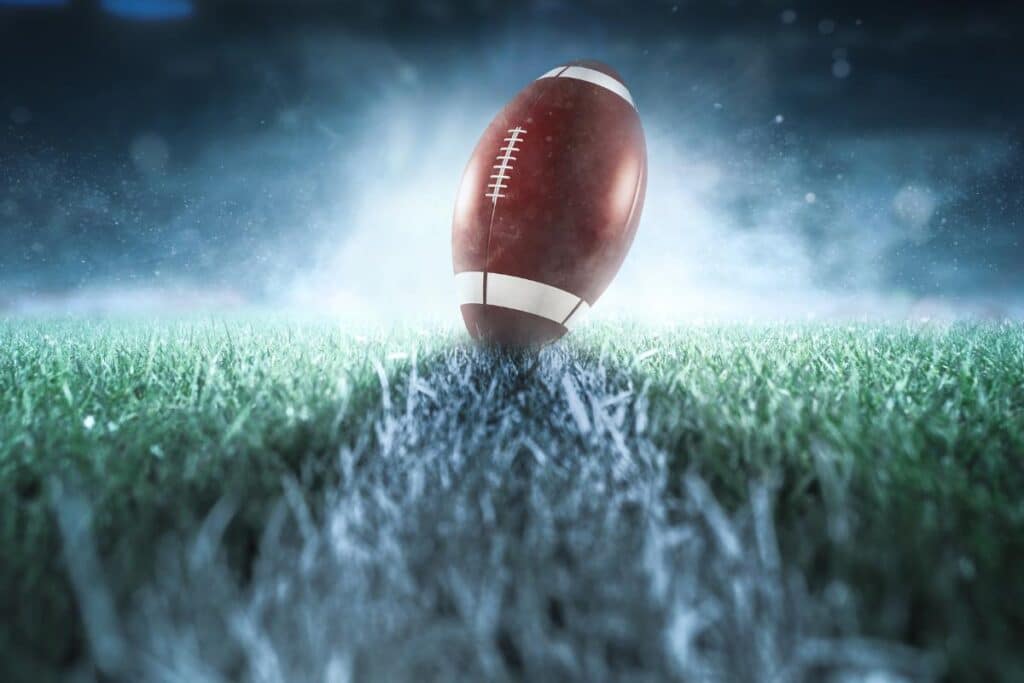



I have read some excellent stuff here Definitely value bookmarking for revisiting I wonder how much effort you put to make the sort of excellent informative website
I frequently blog, and I truly value the stuff you provide. In fact, the piece has piqued my curiosity. I’m going to save your website to my bookmarks and keep coming back for fresh content.
You’re really amazing! I don’t think I’ve ever read anything quite similar. It’s wonderful to find someone who has some unique ideas about this subject. Sincerely, I appreciate you kicking this off. Someone with a little uniqueness is needed on the internet, and that someone is this website!
In addition, I had a wonderful time with that. In spite of the fact that both the narration and the images are of a very high level, you realise that you are anxiously expecting what will happen next. Regardless of whether you choose to defend this stroll or not, it will be essentially the same every time.
Hello my loved one, I want to say that this post is fantastic, well-written, and contains nearly all important data. I woud want to see more posts
My brother recommended I might like this web site He was totally right This post actually made my day You cannt imagine just how much time I had spent for this information Thanks